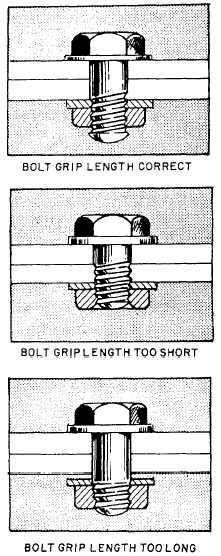The three principal parts of a bolt are the head,
thread, and grip. The head is the larger diameter of
the bolt and may be one of many shapes or designs.
The head keeps the bolt in place in one direction, and
the nut used on the threads keeps it in place in the
other direction.
To choose the correct replacement, several bolt
dimensions must be considered. One is the length of
the bolt. Note in figure 2-19 that the bolt length is the
distance from the tip of the threaded end to the head of
the bolt. Correct length selection is indicated when
the chosen bolt extends through the nut at least two
full threads. In the case of flat-end bolts or chamfered
(rounded) end bolts, at least the full chamfer plus one
full thread should extend through the nut. See figure
2-19. If the bolt is too short, it may not extend out of
the bolt hole far enough for the nut to be securely
fastened. If it is too long, it may extend so far that it
interferes with the movement of nearby parts.
Unnecessarily long bolts can affect weight and
balance and reduce the aircraft payload capacity.
In addition, if a bolt is too long or too short, its
grip is usually the wrong length. As shown in
figure 2-20, grip length should be approximately the
same as the thickness of the material to be fastened.
If the grip is too short, the threads of the bolt will
extend into the bolt hole and may act like a reamer
when the material is vibrating. To prevent this, make
certain that no more than two threads extend into the
bolt hole. Also make certain that any threads that
enter the bolt hole extend only into the thicker
member that is being fastened. If the grip is too long,
the nut will run out of threads before it can be
tightened. In this event, a bolt with a shorter grip
should be used, or if the bolt grip extends only a short
distance through the hole, a washer maybe used.
A second bolt dimension that must be considered
is diameter. Figure 2-19 shows that the diameter of
the bolt is the thickness of its shaft. If this thickness
is 1/4 of an inch or more, the bolt diameter is usually
given in fractions of an inch; for example, 1/4, 5/16,
7/16, and 1/2. However, if the bolt is less than 1/4 of
an inch thick, the diameter is usually expressed as a
whole number. For instance, a bolt that is 0.190 inch
in diameter is called a No. 10 bolt, while a bolt that is
0.164 inch in diameter is called a No. 8.
The results of using a bolt of the wrong diameter
should be obvious. If the bolt is too big, it cannot
enter the bolt hole. If the diameter is too small, the
bolt has too much play in the bolt hole, and the
chances are that it is not as strong as the correct bolt.
The third and fourth bolt dimensions that should
be considered when choosing a bolt replacement are
head thickness and width. If the head is too thin or
too narrow, it may not be strong enough to bear the
load imposed on it.
If the head is too thick or too
wide, it may extend so far that it interferes with the
movement of adjacent parts.
BOLT HEADS.—The most common type of
head is the hex head. See figure 2-20. This type of
head may be thick for greater strength or relatively
thin in order to fit in places having limited clearances.
In addition, the head may be common or drilled to
lockwire the bolt. A hex-head bolt may have a single
hole drilled through it between two of the sides of the
hexagon and still be classed as common. The drilled
Figure 2-20.—Correct and incorrect grip lengths.
2-16


